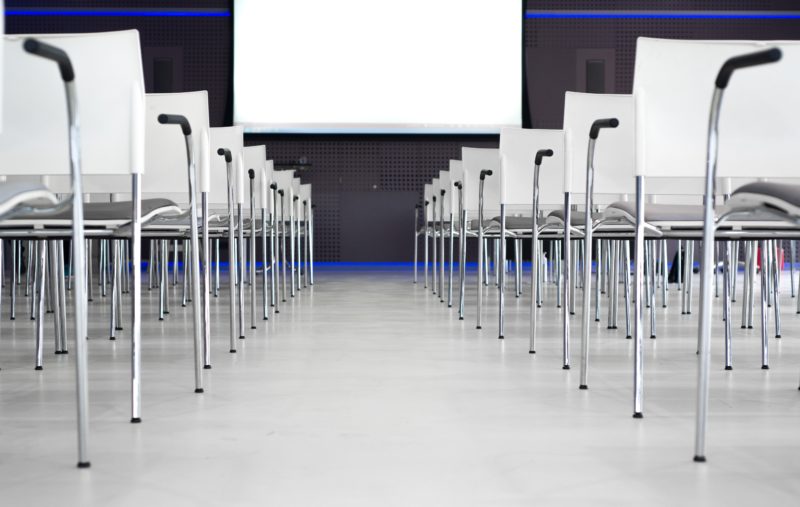
By Evan Hackel
Five Small Things That Add Up to BIG Training Success
Five Small Things That Add Up to BIG Training Success https://csuiteold.c-suitenetwork.com/advisors/wp-content/themes/csadvisore/images/empty/thumbnail.jpg 150 150 Evan Hackel https://secure.gravatar.com/avatar/ffc96667f43826751e09244de553f636?s=96&d=mm&r=g
You’ve booked a room for your training session. You’ve ordered coffee, tea, water, and a table of snacks. Of course, you’ve made sure that the projector and sound system will work. So all the bases are covered, right?
Maybe yes, maybe no. Because the fact is, there are a lot of “moving parts” in any live training session. Paying attention to even the smallest of them can help assure that your day of training will be effective, memorable, motivating, and much more.
Pick the Right Seating Arrangement
Here are some configurations to consider:
- Banquet-style seating, where attendees sit at round tables spread around the training room, works well for training groups of 30 or more.
Benefit: Attendees will already be in groups and there is no need for people to move around for breakout activities.
Downside: Half the people at each table need to turn and twist in order to see the presenter. Because trainees tend to sit with people they already know and like, your trainer might need to mix things up by assigning tables to trainees by putting table numbers on their name tags or have trainees change tables when breaking out into groups.
- Theater-style seating, where attendees sit in auditorium-style rows, can accommodate very large groups of 100, 200 trainees or even more. It works well when your presenter wants to deliver a big or motivational message.
Benefit: This layout focuses on the attention of trainees on what the presenter has to say, by slightly limiting their ability to interact with each other.
Downside: Be sure to consider the training sessions that will follow a theater-style training session. If trainees will need to break out into small groups, you might want to move later training sessions in the day into another room with banquet-style seating, send them in small groups to different rooms, or make other accommodations.
- Seminar-style seating, where trainees sit in a U-shaped formation of chairs with the presenter in front of them, works well in smaller groups of up to 20 trainees.
Benefit: Focuses the attention of the group on what the trainer has to say and encourages group discussion.
Downside: If you are planning a full day of training, it is best to plan to move trainees into other configurations as the day progresses, since sitting seminar-style can get tiring in the long haul.
Offer the Right Food and Snacks
This is especially important when training starts in the early morning. Of course, you or your planner will provide coffee, tea, and bottled water, but the selections that you make beyond that can affect your trainees’ ability to focus and get the most from training.
Opinions differ on what to offer, but the best thinking today holds that it is smartest to steer trainees away from sugary breakfast items – which can cause energy highs followed by energy crashes – by offering fruits and (if they are in your budget) healthy breakfast cereals like granola and protein-rich selections like eggs and breakfast meats.
Consider Circadian Rhythms when Planning Your Training Day
People tend to have high energy levels first thing in the morning, settle down slightly and become attentive by late morning, then become sleepy after lunch. With a little thought, you can plan accordingly.
One option: Because trainees can tend to “nod off” immediately after lunch, schedule breakout sessions, interactive training exercises, and other energizing activities immediately after lunch instead of lecture presentations. Steer away from lectures where information is delivered one-way.
If Possible, Pick Training Rooms with Natural Light
It’s not always possible. But if you have sat in training sessions in rooms with exterior windows, you know that training in natural lighting usually works better because people feel more energized and positive.
Tip: Post-lunch training sessions when people are likely to be sleepy can become deadly in the dark interior or basement rooms.
Allow Adequate Breaks to Check Phone Messages and eMails
If you’re training a group of new employees, they might not need to check too often for incoming new messages – only about once an hour for personal messages. But if your trainees are your current executives, managers or salespeople, allowing more frequent breaks will let them focus more closely on your training.
Tip: Encourage current employees to “triage” incoming messages by having their clients, administrative support staff and others send them text alerts – which are hard to miss – when an important message needs immediate attention.

